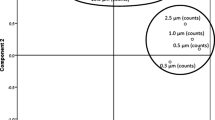Abstract
In our hospital safety guidelines are available for the handling of pentamidine in the day-care department, but no safety ventilation cabin is used because only one patient a day has been treated. The number of patients to be treated, however, is growing, resulting in the need to treat more than one patient a day. To determine the environmental contamination and exposure of health-care workers during and after aerosolised pentamidine treatment of more than one patient with the acquired immunodeficiency syndrome a day a high-performance liquid chromatographic method is used for the detection and quantification of pentamidine. High volume air samples were taken before, immediately after and the day after a treatment session of up to three patients. Also, sediment samples and personal air samples close to the mouth of the health-care workers were taken.
Immediately after a treatment session the air in the room contains 1.0–99.7 μg pentamidine per m3 of air. Before and the morning after treatment no pentamidine could be detected in the air. Sediment samples vary in detectable amounts of pentamidine from <5 to 1165 ng pentamidine/cm2. The personal air samples also show a large variation in quantities of pentamidine: <5–170 ng a filter.
When large amounts of pentamidine in the high volume air samples are found high amounts of pentamidine on the sediment samples and the personal air samples are found as well. This means that the patients treated should be instructed well on how to use the nebulizer correctly and be monitored during treatment. Additional safety measures (for example the use of a safety ventilation cabin) should be taken when more than one patient is treated a day.
Similar content being viewed by others
References
McDiarmid MA, Jacobson-Kram D. Aerosolised pentamidine and public health. Lancet 1989;i:863–4.
Stauffert I, Paulini H, Steinmann U, Sippel H, Estler C-J. Investigations on mutagenicity and genotoxicity of pentamidine and some related trypanocidal diamidines. Mutation Research 1990;245:93–8.
Kacmarek RM. Care-giver protection from exposure to aerosolised pharmacologic agents. Is it necessary? Chest 1991;100:1104–5.
Kacmarek RM. Ribavirine and pentamidine aerosols: caregiver beware! Respiratory Care 1990;35:1034–5.
Berger BJ, Henry L, Hall JE, Tidwell RR. Problems and pitfalls in the assay of pentamidine. Implications for clinical use. Clin Pharmacokinet 1992;22:163–8.
Berger BJ, Hall JE. High-performance liquid chromatographic method for the quantification of several dimidine compounds with potential chemotherapeutic value. J Chromatogr 1989;494:191–200.
Dickinson CM, Navin TR, Churchill FC. High-performance liquid chromatographic method for quantification of pentamidine in blood serum. J Chromatogr 1985;345:91–7.
Smaldone GC, Vinciguerra C, Marchese J. Detection of inhaled pentamidine in health-care workers. N Engl J Med 1991;325:891–2.
O'Riordan TG, Smaldone GC. Exposure of health-care workers to aerosolized pentamidine. Chest 1992;101:1494–9.
Author information
Authors and Affiliations
Rights and permissions
About this article
Cite this article
Ros, J.J.W., Langen, M.C.J., Stallen, P.C.J. et al. Pentamidine aerosols and environmental contamination: health-care workers at risk. Pharm World Sci 18, 148–152 (1996). https://doi.org/10.1007/BF00717731
Issue Date:
DOI: https://doi.org/10.1007/BF00717731




